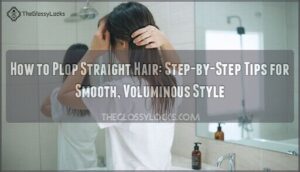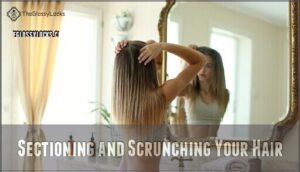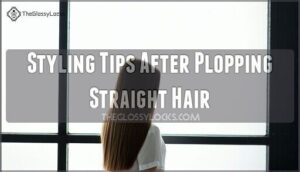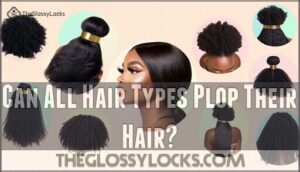This site is supported by our readers. We may earn a commission, at no cost to you, if you purchase through links.
 Ask anyone fighting flat roots and fuzz: the struggle to style straight hair without heat feels endless. You towel-dry, but friction turns your strands into static-charged flyaways. You try air-drying, but your lengths stick to your scalp and never seem to bounce.
Ask anyone fighting flat roots and fuzz: the struggle to style straight hair without heat feels endless. You towel-dry, but friction turns your strands into static-charged flyaways. You try air-drying, but your lengths stick to your scalp and never seem to bounce.
Here’s where hair plopping steps in with a secret weapon you probably already own—a soft cotton T-shirt. This no-fuss technique wraps your hair in gentle fabric, coaxing out smooth, subtle volume and making frizz a distant memory. Mastering how to plop straight hair might change how you think about drying and styling, no heat or fancy tools required.
Table Of Contents
- Key Takeaways
- What is Hair Plopping for Straight Hair?
- Preparing Straight Hair for Plopping
- Choosing The Best Fabric for Plopping
- Step-by-Step Guide to Plopping Straight Hair
- How Long Should You Plop Straight Hair?
- Styling Tips After Plopping Straight Hair
- Common Mistakes When Plopping Straight Hair
- Benefits of Plopping for Straight Hair
- Can All Hair Types Plop Their Hair?
- Frequently Asked Questions (FAQs)
- What kind of fabric should I use for plopping my hair?
- Should I use a product before plopping my hair?
- How often should I plop my hair?
- Should I use cold or warm water for plopping?
- Are there any risks associated with plopping my hair?
- Can you plop hair overnight for straight styles?
- Is it possible to plop hair with color treatments?
- Will plopping affect the longevity of your hairstyle?
- Can plopping reduce scalp oiliness in straight hair?
- What should you do if your hair feels sticky after plopping?
- Conclusion
Key Takeaways
- Plopping straight hair with a cotton T-shirt or microfiber towel reduces frizz, adds volume, and makes styling easier—all without heat.
- Proper prep is key: use a gentle wash, lightweight products, and a wide-tooth comb to avoid breakage and set the stage for smooth results.
- Microfiber towels dry hair faster and limit damage better than cotton, but don’t plop for too long or you’ll risk limp, flattened hair.
- Tailor your technique and timing to your hair type, keeping plop duration under 30 minutes for the best volume and natural shine.
What is Hair Plopping for Straight Hair?
Hair plopping isn’t just for curls—it can transform straight hair, too. If you’re after smooth, bouncy results with less hassle, this method’s worth a closer look.
Here’s what to know before you start.
How Plopping Works
When you wrap your hair up in a soft T-shirt or towel and let it sit, you’re giving your strands a chance to shape up and dry with far less frizz than usual.
Gently drying your hair this way allows moisture to soak in gradually, cuts down on friction, and helps spread product throughout your strands.
The result? Softer curls, a bit of extra lift, and a smoother finish—all from such a simple routine.
Differences From Curly Hair Plopping
With straight hair, the effects of plopping are much more understated. You’ll notice less curl and gentler volume, and it’s common for hair to absorb less product—so a second round of styling might be needed.
Moisture retention, too, is a balancing act—do it too long, and you risk limp or frizzy hair rather than the bouncy softness you’re after.
Surprisingly, straight hair tangles more often than curly hair due to the angles at which the strands meet.
Who Should Try Plopping Straight Hair
If you’re curious about boosting your natural volume, fighting midday flatness, or just want to see what your hair can really do, plopping straight hair might be your kind of experiment.
It’s especially handy if you’ve got fine hair types, struggle with hair damage, or crave low-effort beauty hacks.
Anyone open to new hair styling techniques and gentle hair drying methods should give it a try.
Preparing Straight Hair for Plopping
Getting your hair ready is key if you want your plopping results to look their best. The right prep keeps things smooth and helps you avoid frizz from the start.
Here’s what you’ll need to do before you get wrapping.
Washing and Conditioning Tips
Getting your hair clean is just the beginning if you want that soft, natural shine that lasts all day. The right prep sets the stage for plopping. Want better results? Try this:
- Wash less often to keep natural oils—think intentional Shampoo Frequency
- Choose a lightweight Conditioner Type to avoid limp locks
- Watch your Scalp Health—scrub gently
- Rinse with cool Water Temperature for max shine
Detangling Without Breakage
Even the softest shampoo can leave your hair in knots, so easing out tangles the right way keeps strands strong and happy. Always detangle wet hair gently with a wide-tooth comb, working up from the ends. Sectioning hair helps you spot stubborn snags. Pair gentle brushing with smart hair care tips for less frizz and better hair health.
| Tool | When to Use | Why It Matters |
|---|---|---|
| Wide-Tooth Comb | Wet Detangling | Reduces breakage |
| Gentle Brush | After Sectioning | Controls frizz |
| Rinse Routine | Remove Buildup | Keeps hair healthy |
Prepping With The Right Products
Before you wrap your hair up, choosing the right products will set you up for shinier, smoother results. Stick to lightweight formulas—a mousse or a touch of gel works wonders without weighing hair down.
Pay attention to what’s in your products and how you apply them. Smooth your chosen styling product through your hair so it’s evenly coated—this prevents buildup, keeps your routine easy, and really lets your plop technique boost volume.
Choosing The Best Fabric for Plopping
The fabric you choose for plopping isn’t just a small detail—it shapes your entire result. Your hair reacts differently to cotton, microfiber, or regular towels.
Here’s what you need to know about the options.
Cotton T-Shirt Vs. Microfiber Towel
Choosing between a cotton t-shirt and a microfiber towel for plopping hair? Think of it like picking your wingman for hair drying.
Microfiber towels beat t-shirts in absorption efficiency—drying hair about a third faster and reducing breakage risk. Their finer weave limits friction, helping your hair health.
Cotton t-shirts are eco-friendlier, but can’t match microfiber’s hair-saving power. For instance, microfiber towels are known to absorb more water than cotton alternatives.
Why Fabric Choice Matters for Frizz
Ever notice how the wrong towel can leave your hair looking like you’ve been caught in a static storm? Fabric texture and fiber absorbency—like those in a microfiber towel—are key for gentle drying and frizz reduction.
Microfiber’s smooth weave prevents static buildup, while material breathability allows hair plopping to create frizz-free curls, not frizzy hair.
What to Avoid
Not all fabrics are hair-friendly—some can be a bit like sandpaper for your strands, turning smooth hopes into frizzy reality. For hair plopping and caring for your hair texture, steer clear of these five pitfalls:
- Rough terrycloth towels
- Product overload
- Tension plopping
- Excess twisting
- Overnight plopping with the wrong products
Step-by-Step Guide to Plopping Straight Hair
Getting a smooth, lively finish from plopping straight hair starts with the right prep.
Here’s how you can set yourself up for frizz-free volume. Let’s break it down step by step.
Sectioning and Scrunching Your Hair
Want to set the stage for great volume and texture? It starts with how you section and scrunch your hair.
Divide damp hair into two or three sections—this ensures even application of product and maximizes sectioning benefits. Scrunching techniques matter: cup your hands and lift upward, encouraging root volume.
This is a simple way to boost natural hair styling and curl enhancement.
Adjustments for Hair Length and Layers
Once you’ve got sectioning and scrunching down, it’s time to tweak your technique to fit your hair’s length and layers for even better results.
Short Hair Plopping works best with tighter sectioning, while Long Hair Plopping might need a larger T-shirt for coverage.
If you have layered hair, try dividing it into sections to help spread your products more evenly and bring out your hair’s natural texture.
How Long Should You Plop Straight Hair?
Getting the timing right with plopping makes a big difference in how your hair turns out. Too short or too long, and you mightn’t see the results you want.
Here’s what to watch for as you figure out the sweet spot.
Recommended Plopping Times
When you’re weighing up plopping duration for straight hair, aim for 15 to 30 minutes, adjusting for hair thickness and porosity. Fine hair often needs just 10 to 20, while thick strands benefit from the full half hour.
Skip plopping your straight hair overnight—leaving it wrapped that long can make it go limp.
For a faster routine or if your scalp is sensitive, try micro-plopping instead; it’s perfect for a quick air dry.
Signs You’ve Plopped Long Enough
You’ll know it’s time to unwrap when your hair feels just slightly damp and has started holding its new shape without feeling soggy. Check for early curl definition, a noticeable root lift, and an even dampness level—no heavy wet spots.
If volume feels pronounced and frizz is minimal, hair plopping has done its job. This way, airdrying enhances your texture.
Tips to Avoid Limp or Over-Saturated Hair
Even with that just-right dampness, a few small tweaks can help your hair keep bounce and body—without slipping into flat or soggy territory.
Use a lightweight styling product to prevent product buildup, and keep your plopping duration under thirty minutes.
Make sure your microfiber towel allows air circulation at the roots for lift, frizz reduction, and healthy hair texture.
Styling Tips After Plopping Straight Hair
Once your hair is dry and unwrapped, you’ll want to know how to keep those results looking their best. Simple changes in product and technique can make a real difference.
Here’s what to focus on next.
Enhancing Volume and Texture
Think your straight hair can’t hold volume? Give it the right boost with a few simple moves—clean hands, no tricks, just practical steps that lift your look from flat to full.
- Try a quick Root Lifting technique before you plop.
- Finish with a blast from a diffuser for added bounce.
- Let Texture Sprays coax out natural hair texture.
- Experiment with Overnight Plopping to lock in body.
Using Heat-Free Styling Products
On days when you’d rather skip the heat tools, a good styling product can give your straight hair body and definition without risking damage.
Start with a light mousse for volume boosters and curl definition, or reach for a leave-in conditioner paired with gel for frizz control.
Careful product application after plopping hair really makes those frizz-free curls shine.
Maintaining Results Throughout The Day
Nothing derails fresh, bouncy hair faster than a busy day, so it’s smart to have a few tricks up your sleeve to keep things looking their best.
- Plopping Refresh: Mist curls with water.
- Humidity Control: Use a hair serum.
- Product Touch-Ups: Reapply curl products.
- Overnight Protection: Wrap hair.
- Volume Retention: Gently fluff roots for frizz-free curls.
Common Mistakes When Plopping Straight Hair
Even the most straightforward hair routines can hit a snag when small mistakes creep in. If your results aren’t quite what you expected, you’re not alone.
Here’s what to watch out for as you plop straight hair.
Over-Plopping and Its Effects
Leave your hair wrapped too long and those fresh waves can go limp, almost like bread that’s been left out overnight. Over-plopping doesn’t just lead to Limp Hair—it can slow Drying Time, encourage Product Buildup, stretch strands, and even trigger scalp issues. Aim for 20–30 minutes; it’s enough to get frizz-free curls without sabotaging your style.
| What Happens | Why It Matters |
|---|---|
| Limp Hair | Loss of volume, shape |
| Scalp Issues | Trapped moisture, buildup |
Incorrect Fabric Use
Picking the wrong towel for plopping is like trading your comfy sneakers for sandpaper—your hair feels the scratch, and so does your style.
Rough textures or terry cloth can cause static buildup, lint transfer, and fabric damage, sucking out moisture.
A cotton t-shirt or microfiber towel gives you frizz-free curls without stealing shine—leave classic bath towels for drying dishes, not curly hair.
Product and Technique Missteps
It’s funny how missing just one tiny step can send your curls off course. Here’s where hair plopping and frizz-fighting routines often take a wrong turn:
- Product Overload weighs strands down.
- Incorrect Scrunching mishandles the shape.
- T-Shirt Tension flattens roots.
- Uneven Plopping creates lopsided volume.
- Product Buildup blocks frizzfree curls.
Benefits of Plopping for Straight Hair
When you plop straight hair, you’ll notice more than just a new texture.
This simple method packs in real, everyday benefits for your routine. Here’s what you can look forward to.
Frizz Reduction and Moisture Retention
When you’re tired of fighting stubborn frizz, plopping steps in as your easy shortcut to hair that feels softer and stays hydrated all day.
This routine cushions your strands, helps with Cuticle Smoothing, and improves Hydration Balance.
Letting your hair plop overnight boosts how well your products soak in and helps prevent static, making it a great fit for any routine focused on taming frizz and keeping curls smooth.
Boosting Volume and Shine
If you’re after healthy-looking hair with a natural lift and extra gloss, plopping straight hair is a smart way to bring out both volume and shine without extra effort.
This method combines root lifting and Cuticle Smoothing, especially when paired with shine serums and gentle scalp massage.
The result? Plumping effect, radiant finish, and your natural hair texture on full display.
Minimizing Heat and Mechanical Damage
While you’re enjoying that new shine and fullness, plopping also lets you skip the damage that comes with hot tools and rough towel-drying.
You:
- Limit heat damage repair needs by air-drying.
- Reduce mechanical stress—no more aggressive towel rubbing, just a tshirt or microfiber towel.
- Encourage gentle detangling and protect hair overnight, supporting overall beauty and wellness with hair plopping.
Can All Hair Types Plop Their Hair?
Trying out hair plopping isn’t just for one specific hair type. With a few tweaks, almost anyone can give it a shot—no matter how your hair naturally falls.
Here’s what to keep in mind for different textures and thicknesses.
Results for Fine, Thick, and Layered Hair
Ever wondered how hair plopping transforms different straight hair types? For Fine Hair Results, expect root lift and fuller volume; Thick Hair Results show less frizz and faster drying. Layered Hair Results offer more bounce and visible movement.
Here’s a snapshot:
| Hair Type | Plopping Outcome |
|---|---|
| Fine | More lift, texture |
| Thick | Frizz control, shine |
| Layered | Bounce, separation |
| All Types | Boosted volume |
Adjusting Techniques for Different Textures
No matter how your hair feels in your hands—baby-fine, thick as rope, or somewhere in between—switching up your plopping routine can make all the difference.
- Fine Hair benefits from a lightweight mousse for lift.
- Thick Hair needs more time in a microfiber towel.
- Layered Styles? Finger-coil ends before wrapping.
- Short Hair prefers tighter plopping for defined shape.
When Plopping May Not Work
Sometimes, despite your best efforts and all the right products, your hair just refuses to cooperate with the plopping routine. Oily hair or product buildup might leave strands limp, while scalp issues or existing hair damage can cause extra frizz. Even time constraints or natural hair texture—like super straight or resistant strands—may hold you back from big, bouncy results.
| Challenge | Potential Cause | Fix or Tip |
|---|---|---|
| Limp Results | Oily Hair, Product Buildup | Clarify before plopping hair |
| Lots of Frizz | Hair Damage, Scalp Issues | Use a microfiber towel, go gentle |
| Flat Curls | Time Constraints, Texture | Try shorter sessions, scrunch more |
Frequently Asked Questions (FAQs)
What kind of fabric should I use for plopping my hair?
Like picking the right record for a mellow Sunday, choosing a cotton T-shirt or microfiber towel—thanks to their smooth fabric weave and low static cling—lets you avoid frizz, boost absorbency levels, and preserve natural hair texture.
Should I use a product before plopping my hair?
Using the right product before plopping hair has an impact. Choose lightweight mousse or spray for subtle hold strength, or try argan oil for shine.
Getting the amount right matters more than you’d think. Load on too much and your curls get weighed down and limp. Use too little and you won’t see results.
How often should I plop my hair?
Plopping frequency depends on your hair’s needs. For most, daily plopping isn’t necessary—two to three times a week establishes a great routine, avoiding hair damage, supporting natural curls, and fitting right into a curly hair management approach.
Should I use cold or warm water for plopping?
Opt for cool or lukewarm water to support shine enhancement and reduce scalp sensitivity.
Cold water boosts product absorption and smooths cuticles—key for plopping hair, especially with natural curls—while warm water may impact hair porosity and frizz.
Are there any risks associated with plopping my hair?
Too much time plopping hair or using harsh wraps can cause scalp irritation, product buildup, or even hair breakage.
Uneven drying or discomfort sleeping may also crop up, especially if natural hair care is your beauty routine focus.
Can you plop hair overnight for straight styles?
Leaving your straight hair plopped overnight can boost volume, aid product absorption, and lighten your morning styling routine.
However, too much moisture can throw off scalp balance or cause limpness.
Choose hair products wisely and check product reviews.
Is it possible to plop hair with color treatments?
Yes, you can plop color-treated hair, just be mindful of product buildup and how changes in porosity might affect color fade.
Time treatments wisely, and use gentle products reviewed for damage repair to protect your natural curls.
Will plopping affect the longevity of your hairstyle?
Expect better style longevity and curl retention, especially with the right products, but avoid overnight plopping or excessive buildup.
Smart hairstyle maintenance—like careful hair product selection—keeps your natural curls looking fresh without sacrificing lifestyle flexibility.
Can plopping reduce scalp oiliness in straight hair?
Managing Oily Scalp Plopping can help control excess oil by minimizing scalp contact and limiting friction.
Pairing this method with smart hair product selection and overnight plopping keeps product buildup—and scalp health—balanced without sacrificing natural curls or volume.
What should you do if your hair feels sticky after plopping?
When your hair feels sticky after plopping—like you’ve got glue instead of smooth strands—revisit your application methods.
Rinsing thoroughly, swapping heavy products for lightweight options, or using clarifying shampoos from lines like Living Proof helps banish product buildup.
Conclusion
Picture setting down your hair like a delicate silk scarf—no tugging, no heat, just gravity and care. That’s the quiet magic of learning how to plop straight hair.
Trading friction for fabric, you invite softness, hidden lift, and a new kind of shine. Tweak the timing, feel the results, and let your hair speak for itself.
Sometimes, a simple technique is all it takes to turn routine into ritual—and leave your strands thanking you.
- https://www.toppik.com/blogs/hair-blog/how-to-plop-hair
- https://moonstoneseven.com/blogs/news/understanding-plopping-a-guide-for-curly-and-wavy-hair
- https://better-notyounger.com/blogs/the-better-blog/what-exactly-is-hair-plopping
- https://www.carolsdaughter.com/blog/hair/curly-hairstyles/plopping-hair.html
- https://onlinelibrary.wiley.com/doi/10.1111/ics.12439












